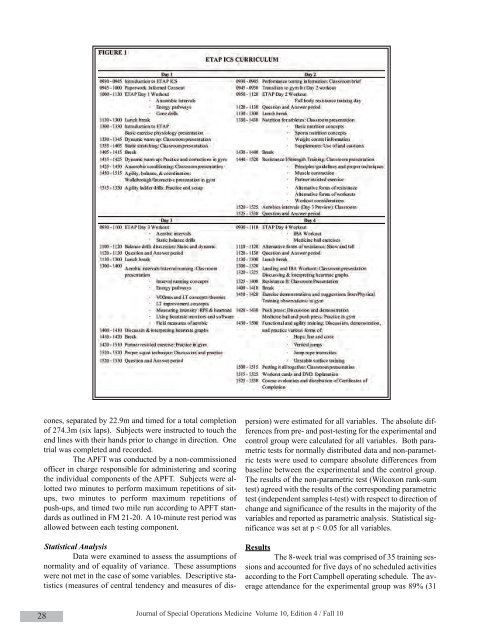Fall - United States Special Operations Command
Fall - United States Special Operations Command
Fall - United States Special Operations Command
You also want an ePaper? Increase the reach of your titles
YUMPU automatically turns print PDFs into web optimized ePapers that Google loves.
28<br />
cones, separated by 22.9m and timed for a total completion<br />
of 274.3m (six laps). Subjects were instructed to touch the<br />
end lines with their hands prior to change in direction. One<br />
trial was completed and recorded.<br />
The APFT was conducted by a non-commissioned<br />
officer in charge responsible for administering and scoring<br />
the individual components of the APFT. Subjects were allotted<br />
two minutes to perform maximum repetitions of situps,<br />
two minutes to perform maximum repetitions of<br />
push-ups, and timed two mile run according to APFT standards<br />
as outlined in FM 21-20. A 10-minute rest period was<br />
allowed between each testing component.<br />
Statistical Analysis<br />
Data were examined to assess the assumptions of<br />
normality and of equality of variance. These assumptions<br />
were not met in the case of some variables. Descriptive statistics<br />
(measures of central tendency and measures of dis-<br />
persion) were estimated for all variables. The absolute differences<br />
from pre- and post-testing for the experimental and<br />
control group were calculated for all variables. Both parametric<br />
tests for normally distributed data and non-parametric<br />
tests were used to compare absolute differences from<br />
baseline between the experimental and the control group.<br />
The results of the non-parametric test (Wilcoxon rank-sum<br />
test) agreed with the results of the corresponding parametric<br />
test (independent samples t-test) with respect to direction of<br />
change and significance of the results in the majority of the<br />
variables and reported as parametric analysis. Statistical significance<br />
was set at p < 0.05 for all variables.<br />
Results<br />
The 8-week trial was comprised of 35 training sessions<br />
and accounted for five days of no scheduled activities<br />
according to the Fort Campbell operating schedule. The average<br />
attendance for the experimental group was 89% (31<br />
Journal of <strong>Special</strong> <strong>Operations</strong> Medicine Volume 10, Edition 4 / <strong>Fall</strong> 10

















